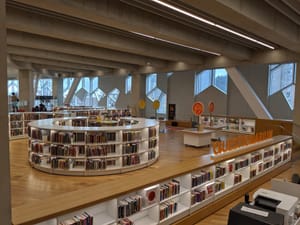I was pleased to participate in LITA’s Top Tech Trends panel at ALA this year (see the video and live coverage).
We were each asked to talk about three trends: current, a bit further out, and a bit further out again. In thinking about the exercise, it seemed to me that it would be interesting to talk about how services are being reconfigured in a network environment, and not just focus on technology as such. This is the first of three blog entries, one devoted to each of my trends. We had three minutes in which to discuss each trend.
The first trend I chose was somewhat broad: mobile. I discussed five ways in which mobile is impacting our services:
- Atomization: get to relevance quickly. Mobile encourages designers to think of atomic services rather than complicated workflows or rich multilayered experiences. And to think about services that are immediately relevant and convenient. Room or equipment booking or bus time tables may become more visible, for example.
- Localization: where you are can matter. WolfWalk is a nice example of a library application which is location aware. It associates materials from NCSU’s special collections with historic buildings on campus. “The application supports a map view with geotagged placemarks for 90 major sites of interest on the NCSU campus, and a browse view for quickly locating a known site by name.”
- Imbrication: our physical and digital spaces overlap. Andy Walsh, of Huddersfield University, for example, discusses how QR Codes (and RFID tags) can be used to connect library places with network information services. And I was interested to see a QR code prominently displayed on one vendor booth at ALA providing a link to further information online.
- Socialization: microcoordination and ad hoc rendezvous affect how we think about space. Mobile communications allow us to coordinate as we go: let’s meet up in an hour in Starbuck’s; I am in Target, will I buy these ones?; I thought you were going to be here 15 minutes ago? I have written before about Starbuck’s as ‘on-demand place’ for the type of ad hoc rendezvous that we are now used to. William Mitchell has written about how this affects our need for different types of space, and we can see how this impacts library space:
“The fact that people are no longer tied to specific places for functions such as studying or learning, says Mr. Mitchell, means that there is ‘a huge drop in demand for traditional, private, enclosed spaces’ such as offices or classrooms, and simultaneously ‘a huge rise in demand for semi-public spaces that can be informally appropriated to ad hoc workspaces’. This shift, he thinks, amounts to the biggest change in architecture in this century. [Economist. “The new oases,” (10 April, 2008). Quoted here.]
- Mobile and cloud go together. We have multiple connection points which offer different grades of experience (the desktop, phone, xBox or Wii, GPS system, smartphone, netbook, Internet radio/music streaming, and so on). While these converge in various ways, they are also optimized for different purposes. A natural accompaniment of this mesh of connection points is a move of many services to the cloud, available on the network across these multiple devices and environments when they are needed. This means that an exclusive focus on the institutional Web site as the primary delivery mechanism and the browser as the primary consumption environment is increasingly partial.
Related:
‘Always on: Libraries in a world of permanent connectivity’
by Lorcan Dempsey
First Monday, Volume 14, Number 1 – 5 January 2009
https://firstmonday.org/htbin/cgiwrap/bin/ojs/index.php/fm/article/viewArticle/2291/2070



